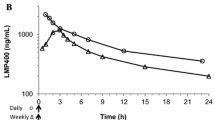Abstract
TAS-103 is a recently developed dual inhibitor of topoisomerase-I (topo-I) and topoisomerase-II (topo-II). TAS-103 has documented cytotoxicity in vitro and antitumor activity against a variety of mouse, rat, and human xenografts in vivo. Purpose: To determine TAS-103 activity against (multi)drug resistant cells in vitro and to delineate its mechanism of action. Methods: TAS-103 was evaluated for activity against three human multidrug-resistant cell lines representing resistance mediated by P-glycoprotein (Pgp)-, multidrug resistance protein (MRP), and lung resistance protein (LRP) as well as one camptothecin-resistant cell line associated with a mutated topo-I enzyme. Drug sensitivity following short (2 h), intermediate (6–8 h) and long term (24 h) exposures were compared. The mechanism of action was studied by evaluating inhibition of topoisomerase-I and -II specific DNA relaxation assays, drug-induced DNA/protein cross-link formation, and competitive DNA intercalation with ethidium bromide. Results: Increasing the exposure time only modestly potentiated TAS-103 cytotoxicity (3–5 fold) demonstrating a lack of strong exposure duration dependency. TAS-103 cytotoxicity was not affected by the presence of any of the drug resistance mechanisms studied. TAS-103 inhibits topo-I and -II activity in DNA relaxation assays, but in our assay system TAS-103 was found to have only a weak ability to induce DNA-protein crosslinks. DNA migration patterns in agarose gel electrophoresis indicate that TAS-103 can interact directly with DNA. Also its ability to displace ethidium bromide which has intercalated into the DNA provides an indication on the nature of drug-DNA interaction. Conclusions: TAS-103 cytotoxicity is not affected by the presence of Pgp, MRP, LRP or mutations in the CAM binding region of the topo-I enzyme and its growth-inhibitory effect appears to be weakly dependent on exposure duration. The presented evidence suggest that the inhibitory effects of TAS-103 on topo-I and -II may in part be related to its DNA binding rather than primarily through stabilization of topo-I or -II intermediates with DNA through specific binding to the enzymes.
Similar content being viewed by others
Author information
Authors and Affiliations
Additional information
Received: 4 November 1998 / Accepted: 3 May 1999
Rights and permissions
About this article
Cite this article
Minderman, H., Wrzosek, C., Cao, S. et al. Mechanism of action of the dual topoisomerase-I and -II inhibitor TAS-103 and activity against (multi)drug resistant cells. Cancer Chemother Pharmacol 45, 78–84 (2000). https://doi.org/10.1007/PL00006747
Issue Date:
DOI: https://doi.org/10.1007/PL00006747




